

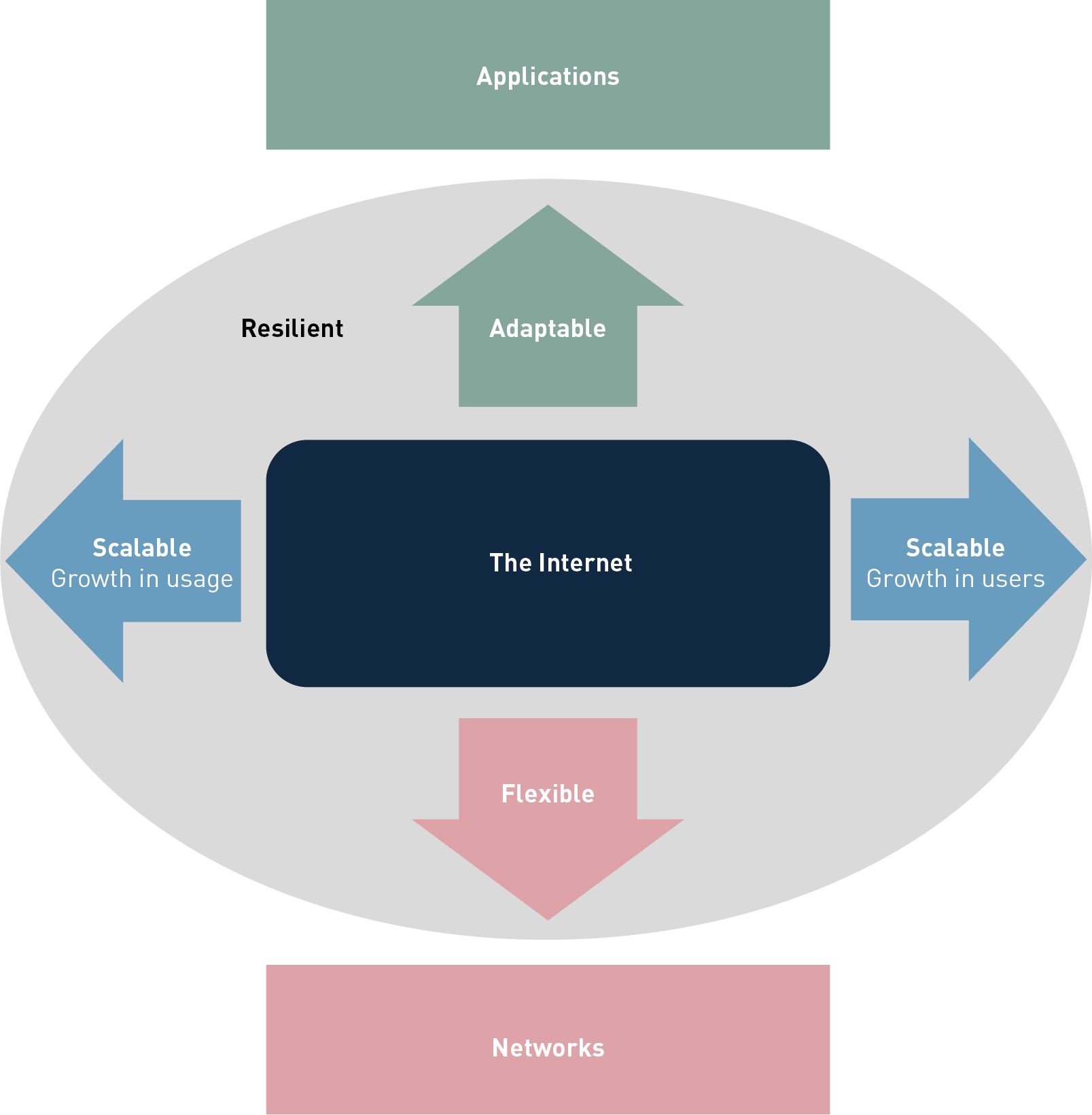
The global success of the Internet is often taken for granted today, based on almost any measure – the number of users and the breadth of their geographic scope, and the level of usage and the depth of reliance on the Internet. Some of the foundations for this success were built into the Internet architecture from the beginning, while others have emerged as the Internet has evolved.
In the paper, we argue that the technical success of the Internet is manifested through four dimensions of success, as demonstrated in the figure. Specifically:
These dimensions of success explain how the Internet has been able to grow from its roots of using dial-up access over traditional copper telephone lines to access mainframe computers for simple text-based uses such as email and file-sharing, into the modern, high-speed Internet used by a wide variety of devices for applications that include multi-media, real-time services, that we know today.
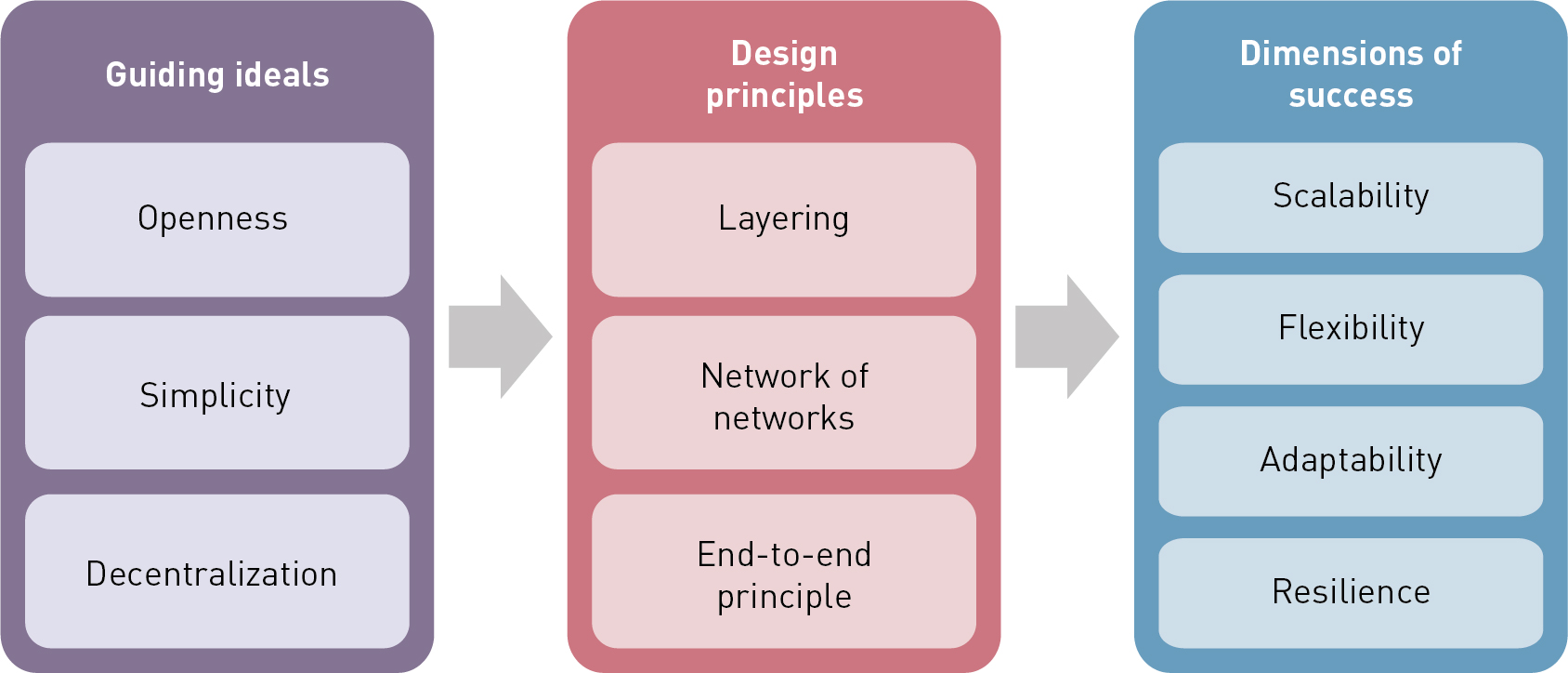
The early development of the Internet was based on openness, simplicity, and decentralization. The adoption of these three guiding ideals resulted from conscious decisions taken by the early Internet developers, and they have shaped the technical, organisational, and operational development of the Internet.
Three well-known design principles that sprung out of the guiding ideals have been central to the Internet’s development and are useful concepts to understand the dimensions of success: layering, network of networks and end-to-end. These principles are highlighted in the figure below.
The Internet is open in a number of ways: the development new standards is open – anyone can contribute, the architecture, standards, protocols, and code are open to be used by all, and the Internet is open to networks arranging their own internetworking with other networks to exchange traffic.
The Internet protocols were given away deliberately, the World Wide Web protocols were given away deliberately. And the idea behind that was just simply to enable people to explore various ways to use these capabilities. It was not proprietary, we [Vint Cerf and Bob Kahn] deliberately thought our way through this and said let's just make this open. I honestly believe that the openness is key to the success of the Internet.
- Vint Cerf, Internet Pioneer
The Internet is simple because it is essentially built from a number of mostly simple protocols that each perform a limited and simple task. The protocols are modular building blocks, stacked or sitting side-by-side in layers, which can be selected and assembled in different ways to solve a more complex task.
In the beginning, the use of the Internet was not clear. There were only some very general applications like file transfer. When you have simple problems, you end up with simple solutions. And simple solutions are often very elegant solutions that, because they lack complexity, can end up scaling and being extensible. The protocols didn't have too much complexity to start, which means they are general and flexible instead of specialized protocols with limited use.
- Alvaro Retana, VP Technology Strategy, Future Networks, Futurewei Technologies
Under the end-to-end principle, the intelligence sits in end devices at the edge of the network, rather than in routers in the core of networks. As a result, applications can be developed and installed in the wide and growing variety of Internet-enabled devices, without making changes in all the networks.
End to end is derived from the layered protocol architecture, basically, but it also meant that important to the success of the Internet is the ignorance of the Internet Protocol layer. By this, I simply mean that it didn't know how things were being carried or what was carried, like a postcard doesn't know how it's carried or what is written on it. This meant that new applications requiring new interpretations of the payload of the Internet packets did not require any change to the underlying network, just re-interpretation of payload by the serving computers at the edge of the Internet.
- Vint Cerf, Internet Pioneer
Under the layering principle, applications are separated from the underlying networks, allowing evolution to occur in some parts of the Internet without affecting others, with the Internet Protocol (IP) as the central, stable, building block separating the layers. This principle enables the following two principles.
The architecture of the host protocol is layered. We learned very quickly that layering is your friend, that you can change all the stuff in the middle of a layer without affecting anybody else as long as the interfaces stay the same. And so that stability was already injected into the thinking for the ARPANET protocol suite, and that carried over into the Internet as well.
- Vint Cerf, Internet Pioneer
The Internet is decentralized in several ways. Most fundamentally, at an organizational level there is no central authority that owns, operates, or controls the Internet as a whole. This decentralized nature of the Internet is also reflected at a technical level, with distributed protocols and autonomous networks with a large degree of freedom in how they implement their services. There is no central acceptance required for new networks to become part of the Internet either – they just need to connect to another network that agrees to transport their traffic. The routing protocol that is used to transport traffic between networks is also built in this decentralized way, automatically propagating new routes to the rest of the network, allowing new networks to be visible without any manual intervention required.
Decentralization is very, very important. We don’t want somebody, be they a king, to control the Internet.
- Professor Xing Li, Electronic Engineering Department, Tsinghua University
The network of networks principle means that each network can be operated independently of the other networks as long as they all use the common Internet protocols to route traffic. This allows existing networks to be connected to the Internet while new networks are deployed, each adapted to its technology and environment.
When the ARPANET was put together it was a network of heterogeneous computers connected with a homogeneous transport mechanism and there was a single point of control. It was clear immediately that you can only scale that up to a certain degree, that that would become a bottleneck right away, in multiple ways. Operationally, from a management point of view, from an economic point of view, and unquestionably from a political point of view. And so, there would be multiple networks.
- Steve Crocker, Internet Pioneer
The Internet is scalable in its technical architecture, operational and business models, which has enabled it to grow quickly and with few imposed constraints in terms of the number of users and the usage per user, while average Internet speeds keep rising.
The Internet has grown by orders of magnitude over the last 60 years, from an Internet that was used by a small group of researchers to one that is used worldwide for every purpose imaginable, and it still works today – a major success. The first thing that highlights the Internet’s success would be scale. The fact that underpinning the Internet today is a series of protocols which have demonstrated their ability to scale to provide seamless connectivity to all corners of the world. Also the fact that we've been able to have nonlinear scalability in the amount of traffic that we can move across the Internet.
- Paul Gampe, CTO at PCCW
The Internet is flexible to different types of underlying networks ranging from high-speed optical networks to ad-hoc wireless networks, each of them suited to different user requirements, geographies and socio-economic characteristics of countries, regions and people.
“Wajan” is wok in Indonesian, as in the dish used for cooking. Combining that with the Indonesian for parabolic, you get “WajanBolic”, which you can find in many online shops. It’s becoming commercial. They are selling actual woks to be used for WiFi networks.
- Onno Purbo, lecturer at IBI Darmajaya
The Internet is adaptable in that it keeps supporting new applications that are continually emerging, including services historically provided by dedicated networks (converged communications and broadcast services) as well as newly digitised and networked services such as online banking, remote health, and ride sharing.
The invention of new services and fundamentally new activities on the Internet was built in from the beginning, when we defined the original architecture of multiple layers. I remember saying these layers are provided for convenience in a sense, rather than as an imposition and you're welcome to add layers, impose intermediate layers or ignore them and go all the way down to essentially the bottom, which in the case of the current Internet would mean going down to the IP layer.
- Steve Crocker, Internet Pioneer
The Internet has been resilient to a range of shocks, including very recently the dramatic increase in usage, and changes in traffic types and usage patterns, resulting from the Covid 19 pandemic; it has also proven broadly resilient to attacks and challenges thrown at the underlying technical principles.
If you think about the things that happened during the pandemic, the ability to scale up the infrastructure on incredibly short notice and grow networks in the span of a month the same amount that they usually grow in a year or two, and be able to support every new need that people had, whether that's video conferencing or sharing virus contagion data. That really speaks to the power of the generality of the network.
- Dr Alissa Cooper, VP/CTO at Cisco
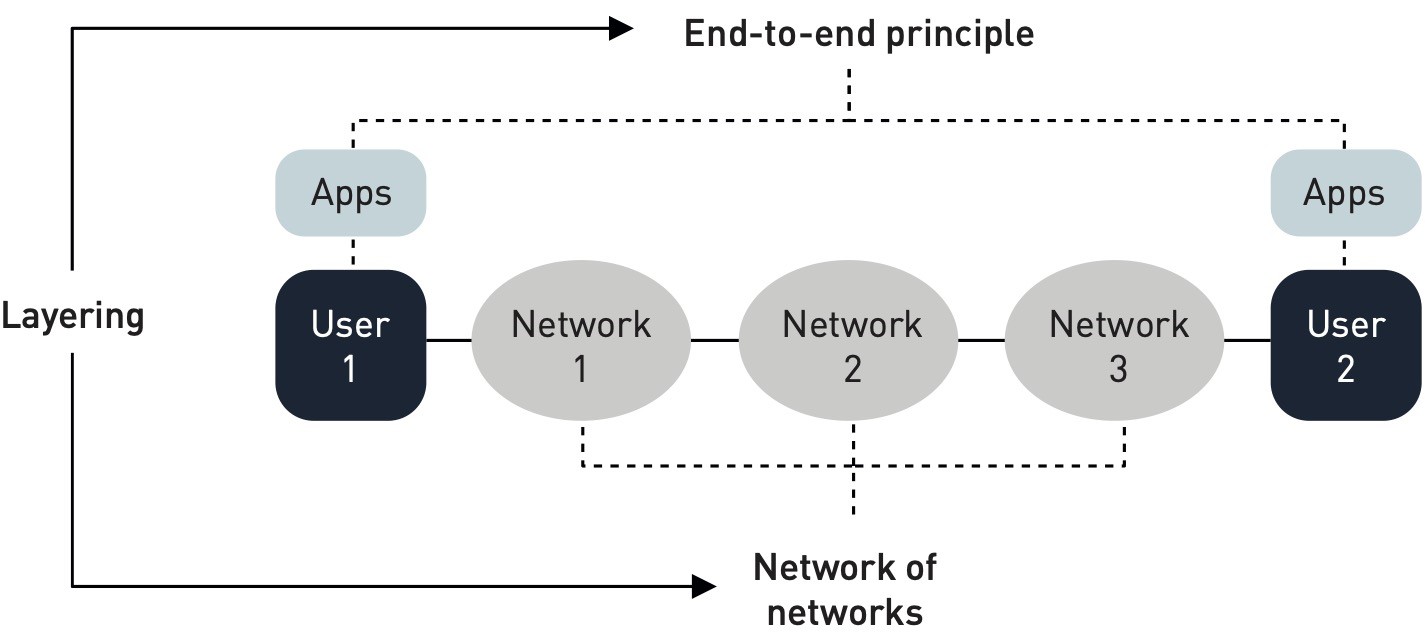
Under the layering principle, applications are separated from the underlying networks, allowing evolution to occur in some parts of the Internet without affecting others, with the Internet Protocol (IP) as the central, stable, building block separating the layers. This principle enables the following two principles.
The network of networks principle means that each network can be operated independently of the other networks as long as they all use the common Internet protocols to route traffic. This allows existing networks to be connected to the Internet while new networks are deployed, each adapted to its technology and environment.
Under the end-to-end principle, the intelligence sits in end devices at the edge of the network, rather than in routers in the core of networks. As a result, applications can be developed and installed in the wide and growing variety of Internet-enabled devices, without making changes in all the networks.
These three design principles in turn have contributed to the different dimensions of the success of the Internet which follow: Scalability, Flexibility, Adaptability, and Resilience.
The figure illustrates the rapid growth of the Internet’s user base from an estimated 2.6 million in 1990 to 3.9 billion (more than half of the global population) in 2019. In the paper we also show that not only is the number of users growing, which increases the total amount of traffic generated, but the traffic per user is also growing, showing an incredible ability to scale. Remarkably, despite more users, and more traffic per user, connections speeds are increasing over time, demonstrating that the Internet has scaled such that it not only met growing demand but improved user experience.
In the paper we explain how the underlying design principles, particularly layering and network-of-networks, have enabled growth in the geographic reach of the Internet, while also scaling so that speeds are improving over time. This has allowed introduction of new networks that give increased capacity, while at the same time the routing system has scaled well to the increased number of networks.
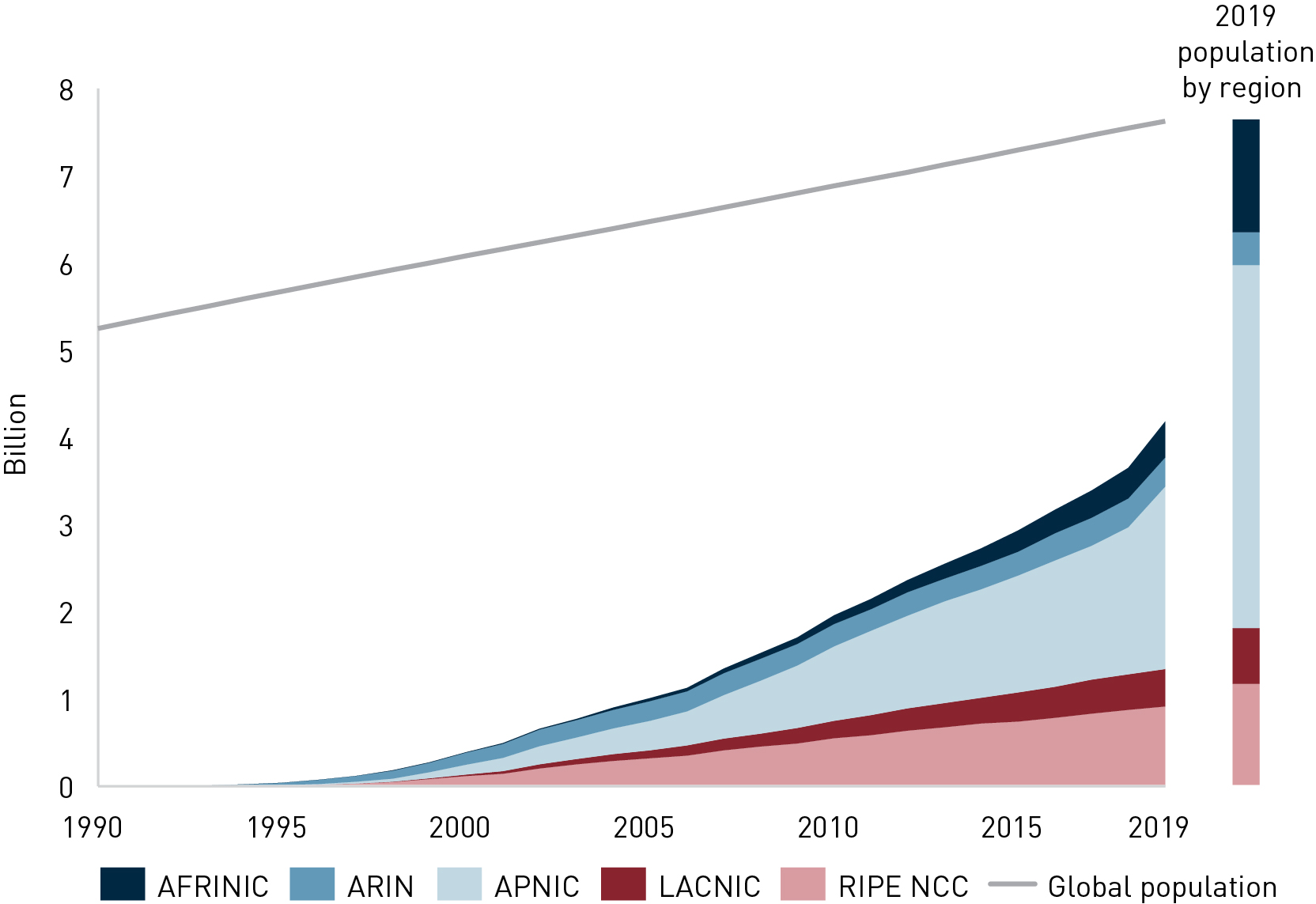
Internet users by RIR region, overlaid with global population [Source: ITU, World Bank, 2021]
The network of networks principle allows networks to be developed and run independently and with different network technologies, From the beginning, the Internet’s flexible protocol suite has supported a wide range of underlying physical network technologies (as shown in the figure, using Australia as an example). As the Internet has grown and matured, new underlying network technologies are added, from terabit optical networks to high-speed mobile and low-power IoT networks, alongside the likes of low-tech WajanBolic or WokFi networks in Indonesia that use Wok’s as antennas. These networks are all able to interconnect to exchange traffic.
The flexibility of the Internet to accommodate new network technologies starts from the layering principle, which separates the end-to-end routing of IP traffic from the underlying network technologies. Also, the network of networks principle states that each network is independent and can use its own technology as long as it runs IP. These networks must interconnect to create the Internet, and this is done with the Border Gateway Protocol (BGP) as the technology, and using arrangements negotiated between the networks to exchange traffic, including peering and transit. As the number of users has grown in regions, the number of networks can grow correspondingly, depending on the markets and demand.
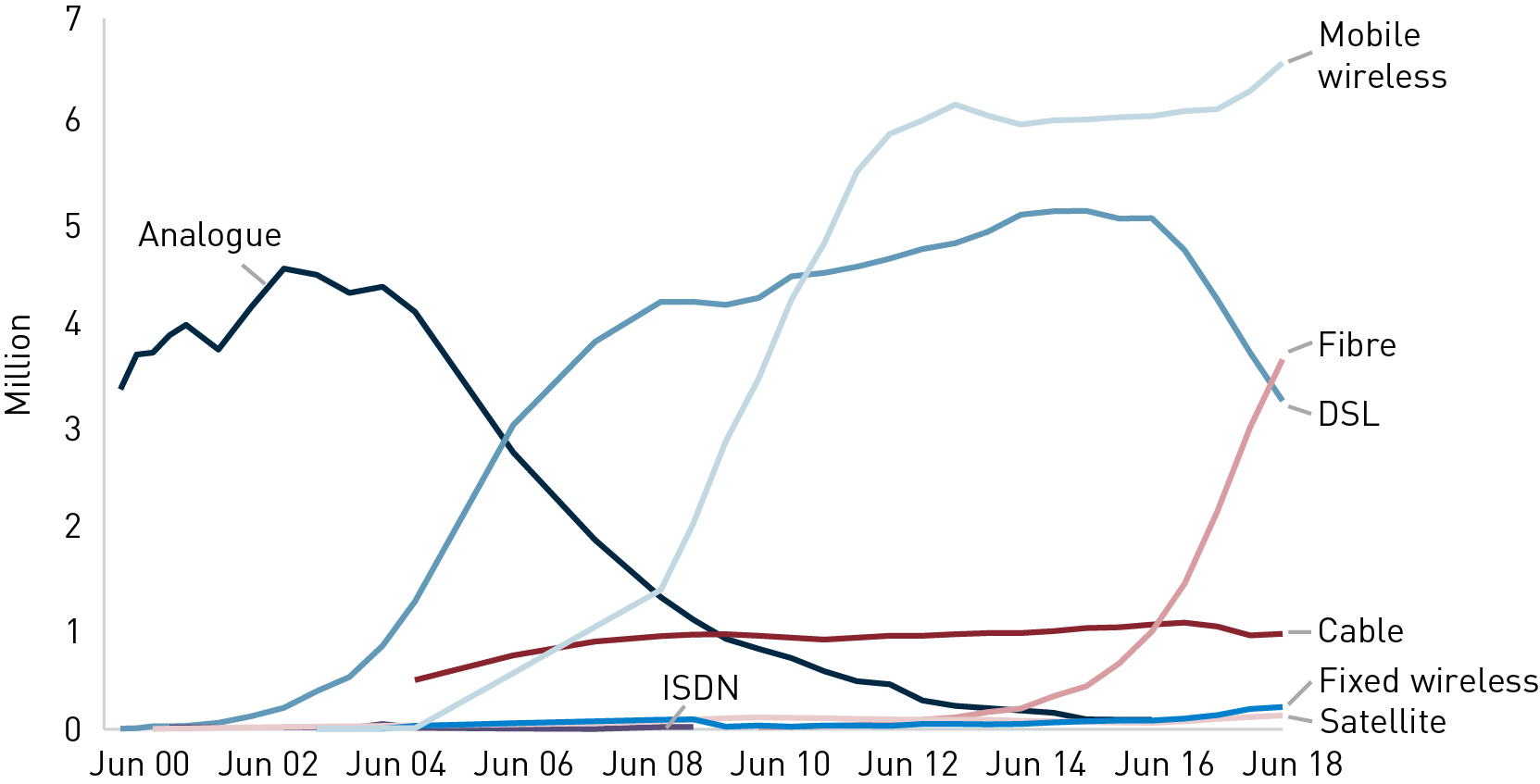
Number of Internet subscriptions by access connection, Australia [Source: Australian Bureau of Statistics, 2021]
As the early Internet grew, it transformed. Users began messaging each other, email was born and the Internet was no longer just a means of accessing computing power and sending files, but a way of communicating and socializing. As the Internet grew, two application platforms emerged over several decades, and helped drive the uptake of the Internet. The first was the World Wide Web, which emerged in the early 1990s, and the second was mobile app stores, which became popular in the late 2000s. Both platforms were made available owing to the openness of the Internet.
Layering and the end-to-end principle are central to supporting a wide range of applications. As the requirements of applications have evolved, the end-to-end protocols at the transport layer have also progressed accordingly, with the introduction of QUIC as an alternative to TCP, and the increasingly popular TLS end-to-end encryption for HTTP, both shown in the figures. Interestingly, several of these changes are driven by content providers, as they became involved in how their content is delivered.
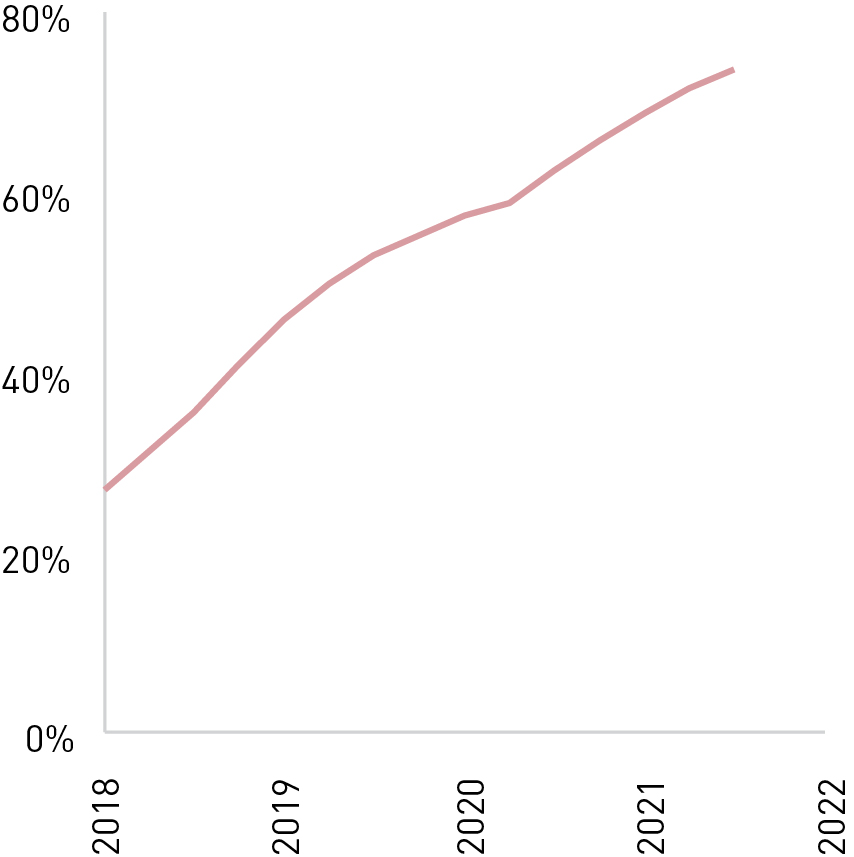
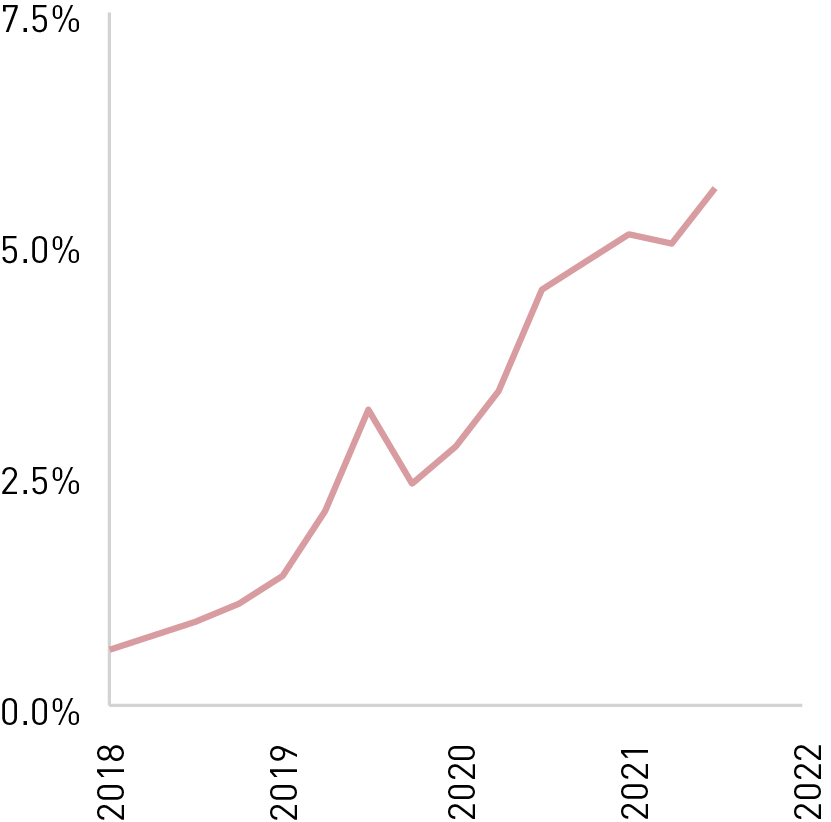
Percentage of websites using HTTPS (left) and QUIC (right) [Source: W3Techs, 2021]
The Internet has proven to be resilient over time in the face of noteworthy internal changes and external challenges. Indeed, the very growth of the Internet in terms of the number of users and their usage, and the emergence of new networks and applications is an indirect confirmation of resilience. Over the years there have been many concerns expressed about the possible collapse of the Internet, be that due to uncontrolled congestion, the collapse of the interdomain routing system or security threats. While there are events where significant services or regional networks are affected, the Internet as a whole has been able to handle a range of challenges.
The impact of the Covid-19 pandemic serves as a good illustration of the resilience of the Internet. With more than half of the global population on lockdown by April 2020, Internet usage skyrocketed, as illustrated in the figure. The Internet proved resilient: supply was increased to meet demand, content providers reduced streaming bit rates, and operators accelerated capacity upgrades.
The resilience of the Internet stems both from fundamental technical properties such as the simple and distributed nature of Internet routing protocols, and from operational practices and methods that have been developed over time by network operators. Resilience also encompasses some measures that violate the design principles in response to challenges, without fundamentally altering the nature of the Internet.
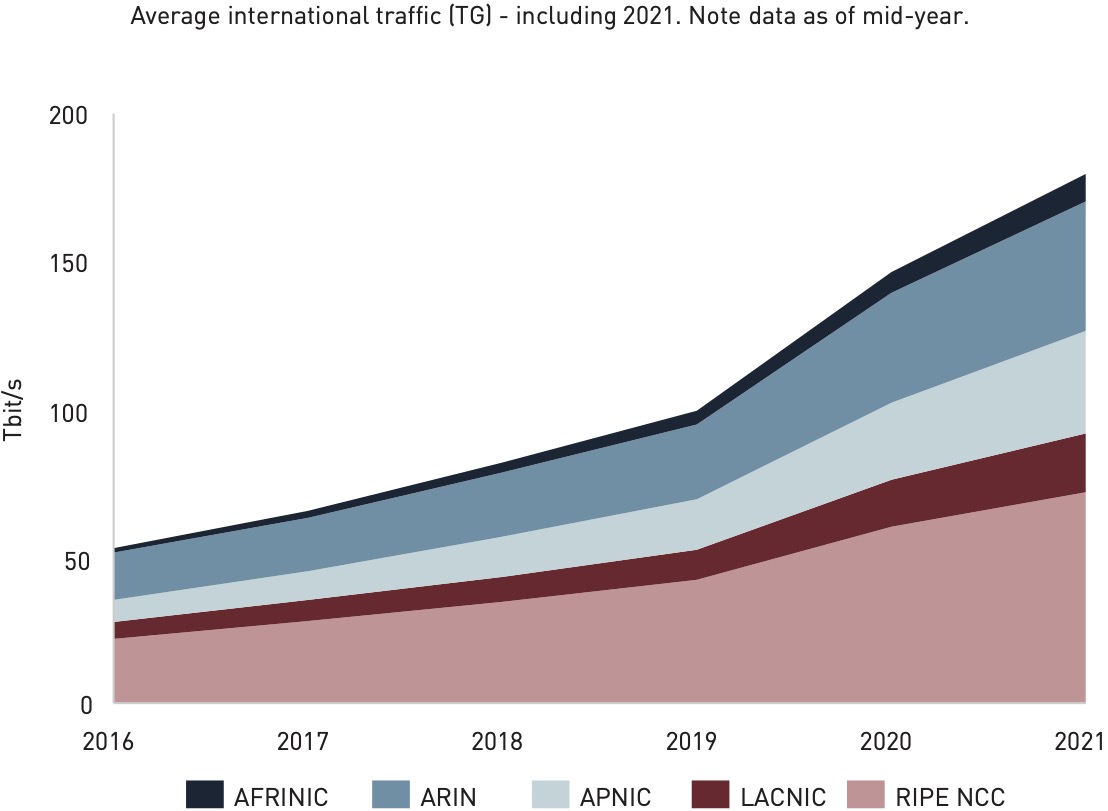
Average mid-year international traffic [Source: Telegeography]
The current Internet is built on the fundamental guiding ideals of openness, simplicity and decentralization. These guiding ideals are expressed in the three design principles layering, network of networks and end-to-end. The design principles are not absolute rules and they are sometimes bent or broken to achieve certain goals, as shown in the report. However, the ability to accommodate violations of the design principles highlights that these are principles and not absolute design rules, and they have not threatened the success of the Internet.
The success of the Internet has turned it into the world’s most important system for connecting people and sharing information. The Internet continues to develop, as described in this paper, while maintaining its success. New technical protocols replace or supplement existing ones, new network technologies are developed, and the network continues to adapt to new applications. Such developments are natural and necessary for the Internet to stay relevant. As the Internet continues to evolve, we believe it is important to recognize and maintain the guiding ideals and design principles that have contributed to the scalability, flexibility, adaptability and resilience that represent the dimensions of success for the Internet today.